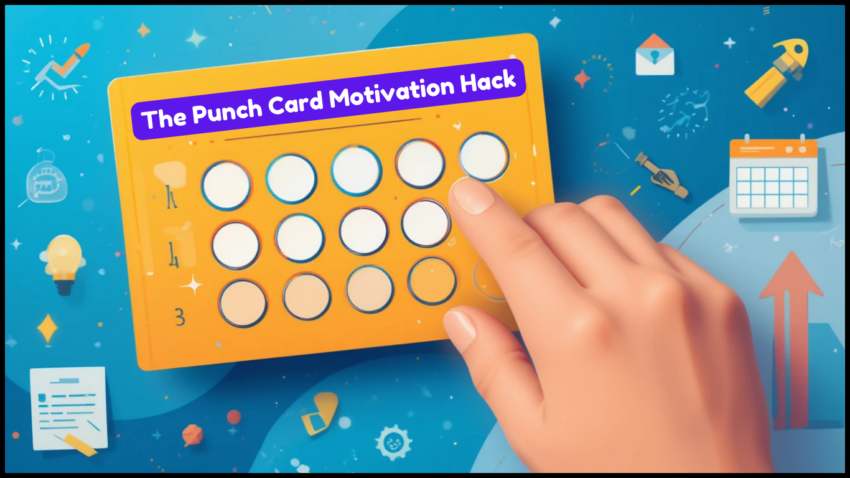
The Punch Card Motivation Hack: 5 Therapist-Approved Strategies to Achieve Your Goals
Increase your motivation with the Punch Card Method! Discover 5 therapist-approved strategies to track progress, build habits, and easily achieve your goals. Learn how this simple yet powerful system keeps you on track with visual reinforcement and reward psychology.
Staying motivated and persistent towards our goals is one of the biggest challenges we face. Whether it’s exercising regularly, reading more books, forming a new habit, or staying productive at work, the excitement of starting something new often fades over time. We lose motivation, get distracted, or feel overwhelmed by the journey ahead.
But what if there was a simple, therapist-approved way to keep you engaged and motivated until you reach your goal?
Enter the Punch Card Motivation Hack – a visual, rewards-based system that helps you track progress and stay on course. Inspired by the classic punch card system used in coffee shops and loyalty programs, this method turns goal attainment into a game, making the process fun, structured, and psychologically rewarding.
Why Does Punch Card Motivation Hack Work?
This method isn’t just about marking progress—it uses the science of motivation in three powerful ways:
✔️ Visual reinforcement: Seeing your progress builds momentum and encourages consistency.
✔️ Habit formation: By creating a structured system of rewards, you reinforce positive behavior.
✔️ Reward psychology: Small rewards along the way activate the dopamine system, making it easier to stay motivated.
What You'll Learn in This Post
In this article, we’ll analyze:
✅ How the Punch Card Motivation Hack works and why it’s so effective.
✅ 5 Therapist-Approved Strategies to create and use your own punch card system.
✅ How to customize it for different goals—fitness, study, productivity, and more.
✅ Pro tips to stay on track and avoid motivation burnout.
By the end of this post, you’ll have a simple, actionable tool that makes staying motivated feel effortless. Let’s dive in! 🚀
What is the Punch Card Motivation Hack?
At first glance, the punch card motivation hack may seem like a simple system – but it’s rooted in a powerful psychological principle: tracking progress through visual reinforcement. This method takes inspiration from the traditional punch cards used in businesses and repurposes them as a tool for personal motivation and habit-building.
A Brief History of Punch Cards
Punch cards have been around since the early 1900s, originally used for business operations and data processing. They were typically seen in two main areas:
1. Employee attendance and payroll – Businesses used punch cards to track employee work hours. Each time an employee arrived or left work, the card was physically punched. This system ensured accountability and simplified attendance tracking.
2. Customer loyalty programs – Many stores, especially coffee shops and retail businesses, offered punch cards as a rewards system. Customers would get a punch for each purchase, and after punching a certain number of times, they would receive a free product or discount. This encouraged repeat business and reinforced positive behavior (customer loyalty).
These punch card systems worked because they gave users a sense of progress and tangible rewards – which is why they could be used again and again for personal motivation and goal achievement.
How the Punch Card Concept Has Been Adapted for Goal Tracking
In the realm of self-improvement, productivity, and habit formation, the punch card method works as a visual progress tracker. Instead of getting a punch for buying coffee or working a shift, you punch or mark spaces when you complete small steps toward your goal.
For example:
✔️ Fitness goals – Each completed workout earns a punch. After 10 workouts, you reward yourself with a treat.
✔️ Reading goals – Each completed chapter earns a punch. After finishing 5 books, you buy a new book.
✔️ Productivity goals – Completing daily tasks earns a punch. After a completed card, you enjoy a guilt-free break.
✔️ Quitting bad habits – Each day without a bad habit (e.g., smoking, junk food) earns a punch, leading to a long-term reward.
By combining visual tracking and reward psychology, the punch card motivation hack keeps motivation high and builds consistency over time.
Real-Life Examples of Where It Works
Many successful people and businesses use progress tracking and milestone-based rewards to stay on track with their goals. Here are some everyday applications:
- Fitness trainers and coaches – Many people use progress-tracking methods similar to punch cards to help clients stick to workouts.
- Education and study plans – Students and teachers use milestone-based tracking to reinforce learning and maintain motivation.
- Self-discipline and productivity preceptor – High achievers use methods like goal-tracking boards, checklists, and punch-cards to accomplish tasks.
By implementing this therapist-approved motivation hack, you can create a structured, rewarding, and fun way to stay consistent and meet your goals! 🚀
Why Therapists Recommend the Punch Card Method
The punch card motivation hack isn’t just a fun way to track goals—it’s backed by psychology and recommended by therapists to build habits, stay motivated, and reduce mental barriers. Here’s why this simple system is so effective.
1. Visual Progress Tracking: The Power of Seeing Progress
Our brain responds positively to visual cues, which is why tracking progress in a tangible way (like checking a box or punching a card) keeps us motivated.
✔️ Psychological boost: When you see the punches slowly filling up on a card, it reinforces a sense of accomplishment, making you want to keep going.
✔️ Momentum effect: The more progress you see, the more committed you feel to finishing what you start.
✔️ Reduces procrastination: Instead of getting overwhelmed by a big goal, you focus on one step at a time – just getting the next punch in.
📌 Example: If you’re trying to exercise every day, seeing 8 of the 10 punches on your card complete motivates you to get the last two punches in so you don’t break your streak.
2. The Dopamine Effect: How Small Wins Keep You Motivated
Dopamine is the brain’s “feel good” neurotransmitter, released when we experience pleasure or accomplish something. The punch card system utilizes this natural reward mechanism by providing frequent small wins, which keeps motivation levels high.
✔️ Instant gratification: Each punch or checkmark delivers a small dose of accomplishment, reinforcing the habit.
✔️ Progress feels fun: Instead of waiting weeks or months for a big win, small milestones build excitement along the way.
✔️ Prevents burnout: By celebrating small steps, you avoid feeling like the goal is too far away and not worth pursuing.
📌 Example: A student using punch cards to track study sessions gets a dopamine boost every time they complete a session, making studying feel rewarding rather than a chore.
3. Habit Reinforcement: Building Long-Term Success
Practitioners value habit formation as the key to long-term success. The Punch Card Method is a structured, positive reinforcement system that naturally strengthens good habits.
✔️ Repetition builds routines: By completing actions over and over again, they become second nature.
✔️ Rewards make habits stable: Linking habits to small rewards increases the likelihood of long-term success.
✔️ Eliminates the struggle of willpower: Instead of relying on motivation, the system automates consistency.
📌 Example: If someone is trying to drink more water every day, punching a card every time they drink a glass of water trains their brain to associate hydration with progress, making it easier to keep going.
4. Reducing Decision Fatigue: Simplifying Daily Choices
Decision fatigue occurs when we think too much about tasks, leading to procrastination or procrastination. The punch card method removes uncertainty by providing clear, pre-defined actions to follow.
✔️ No overthinking: You simply follow the system – when you complete a task, you punch the card.
✔️ Keeps you on track: Instead of wondering, “Did I make enough progress today?”, the card tells you exactly where you stand.
✔️ Reduces stress: A structured system reduces anxiety about achieving your goals.
📌 Example: A person trying to wake up early can use punch cards to track each successful morning, eliminating the need to question whether they are making progress.
Therapists recommend the punch card motivation hack because it turns goal-setting into a simple, rewarding, and effective system. Whether you’re building a new habit, wanting to stay productive, or quitting bad habits, this method provides a clear path to staying motivated, reducing stress, and achieving success.
5 Therapist-Approved Strategies to Implement the Punch Card Hack
Now that you understand why the punch card motivation hack works, it’s time to put it into practice. The key to success is to create a system that fits your goals, lifestyle, and motivation style. Here’s how to do it in five simple steps.
1. Choose a Specific Goal and Define Milestones
The biggest mistake people make when setting goals is being too vague. Instead of saying, “I want to be healthier,” clearly define what this looks like in measurable steps.
✔️ Why clarity matters: The brain responds better to clear, actionable goals than abstract goals. The more specific your goal is, the easier it will be to track progress.
✔️ Break it down into milestones: Instead of setting one big goal at once, break it down into smaller, manageable steps that lead to success.
📌 Examples:
✅ Workout consistency – “Complete 10 workouts = 1 reward.”
✅ Study habits – “Study 30 minutes a day = 1 punch.”
✅ Quitting a bad habit – “Every soda-free day = 1 punch.”
💡 Tip: The easier the first few punches are, the more momentum you’ll be able to build!
2. Create Your Own Punch Card System
Once your goal is set, it’s time to design your own punch card system. You can keep it simple and traditional or go digital.
✔️ DIY paper punch cards:
Get index cards, printed templates, or notebooks.
Use stickers, stamps, or hole punchers to mark completed tasks.
Customize it with colors, goal names, or motivational quotes.
✔️ Digital options:
Use an app like Habitica, Streaks, or Simple Notes App to track progress.
Create a Google Sheet or Trello board with checkboxes.
Use a habit tracker app with built-in reminders.
📌 Short-term vs. long-term goals:
🔹 Short-term goals (e.g., drinking more water, daily meditation) → 10-20 punches per cycle.
🔹 Long-term goals (e.g., lose weight, save money) → break down into smaller steps (e.g., 5 milestones of 10 punches).
💡 Tip: Physical punch cards work better for visual motivation, while digital tracking is great for convenience and reminders. Choose what works for you!
3. Set Small and Big Rewards
The reward system is what makes this hack so effective. When you associate an effort with a positive outcome, you’re more likely to stay motivated and persistent.
✔️ Why rewards work:
They activate the brain’s reward center, reinforcing behavior.
They make long-term goals more exciting and achievable.
They prevent burnout by keeping motivation high.
📌 Examples of small vs. big rewards:
🔹 Small rewards (daily/weekly):
🎯 A great coffee
🎯 Watching an episode of your favorite show
🎯 A guilt-free nap
🎯 10 minutes of scrolling on social media
🔹 Big rewards (milestone achievements):
🏆 A weekend trip
🏆 A new book, gadget, or outfit
🏆 A spa or self-care day
🏆 A special dinner at your favorite restaurant
💡 Tip: Connect the rewards to the goal itself (e.g., fitness goal → new workout gear). This keeps the momentum going!
4. Keep the Punch Card Visible and Accessible
Out of sight = out of mind! The more visible your punch card is, the more likely you are to stick to it.
✔️ Why location matters:
Seeing your punch card daily serves as a constant reminder.
It reduces the mental effort of remembering to track progress.
It increases accountability and motivation just by being in sight.
📌 The best places to keep your punch card:
📍 Fridge or kitchen wall – great for fitness or diet goals.
📍 Work desk or laptop – perfect for productivity-related goals.
📍 Planner or journal – ideal for tracking self-improvement goals.
📍 Phone wallpaper – a digital punch card that’s always in sight.
💡 Tip: Combine visual tracking with reminders (sticky notes, alarms, or a habit-tracking app).
5. Stay Flexible and Adjust Your System
Not every system works perfectly from day one. If you lose motivation or struggle to stay on track, don’t give up – adjust!
✔️ When to change a system:
Too easy? Increase the challenge (for example, require more punches before reward).
Too hard? Decrease the difficulty (for example, add smaller milestones).
Lost interest? Change the reward system or add new motivation.
Missed days? Don’t give up – just restart the cycle and keep going.
📌 How to stay on track:
✅ Use accountability partners (friends, social media or a coach).
✅ Reevaluate your goals monthly and make changes if needed.
✅ Celebrate progress, even if it’s slower than expected.
💡 Tip: The punch card hack isn’t about being perfect – it’s about progress. Adjust the system until it works for you.
By implementing these 5 therapist-approved strategies, you can turn the punch card motivation hack into a game-changing tool for achieving your goals. Whether you’re creating new habits, improving productivity, or breaking bad habits, this method makes success structured, rewarding, and fun!
Who Can Benefit from the Punch Card Method?
The punch card motivation hack is a versatile strategy that can help anyone looking to build better habits, stay consistent, and achieve their goals. Whether you’re a student, a working professional, or someone trying to break free from procrastination, this method can provide the structure and motivation you need to succeed.
Let’s take a closer look at who can benefit the most from this strategy and how it can be applied to different areas of life.
1. Students: Build Better Study and Learning Habits
Students often struggle with procrastination, time management, and consistency. The punch card method can turn studying into a fun and rewarding process instead of a stressful one.
✔️ How students can use it:
🎓 Track daily or weekly study sessions (e.g., 1 punch in 30 minutes of study).
🎓 Reward consistency with small gifts (e.g., snack breaks, social media time).
🎓 Use it for schoolwork, online courses, or reading goals.
📌 Example:
A student preparing for exams can create a punch card with 50 study sessions and reward themselves with a fun weekend outing after completing them.
💡 Tip: Pair it with flashcards, a Pomodoro timer, or a planner for maximum effectiveness.
2. Professionals and Entrepreneurs: Boost Productivity and Time Management
Busy professionals and business owners often struggle with focus, task completion, and work-life balance. Punch card systems can provide a structured way to track and reward productivity.
✔️ How professionals can use it:
💼 Complete high-priority tasks before punching a card.
💼 Use a “deep work” system (e.g., 4 hours of focused work = 1 punch).
💼 Reward consistency with self-care breaks or small incentives.
📌 Example:
An entrepreneur might set up a punch card where each completed sales call or client meeting earns a punch — and after 20 punches, they reward themselves with a nice dinner or a day off.
💡 Tip: Use digital punch cards to track tasks more efficiently.
3. Fitness Enthusiasts: Stay Consistent with Workouts and Health Goals
Fitness motivation often comes in waves, making it easy to skip workouts or get off track. The punch card method turns exercise into a visual, goal-oriented challenge that keeps motivation high.
✔️ How fitness enthusiasts can use it:
🏋️♂️ Get a punch for each completed workout (for example, 1 workout = 1 punch).
🥗 Track healthy habits like water intake, meal prep or steps walked per day.
🏆 Reward progress with a new workout outfit, a fitness tracker or a spa day.
📌 Example:
A runner training for a marathon could use punch cards to track training sessions, rewarding themselves with a new pair of running shoes after 30 punches.
💡 Tip: Keep the punch cards in a visible place like your fridge or gym bag to boost daily motivation!
4. Habit-Builders and Self-Improvers: Make Positive Changes Stick
Forming a new habit or breaking a bad one requires consistent effort. The punch card system serves as a reinforcement tool that helps you stay on track and celebrate small wins.
✔️ How habit builders can use it:
🧘♀️ Meditation: Track daily mindfulness sessions (for example, 10 punches = a relaxing spa day).
📚 Reading: Set a goal to read a certain number of pages per day.
🚫 Breaking bad habits: Use punch cards to track smoke-free, soda-free, or junk food-free days.
📌 Example:
Someone trying to form a gratitude journaling habit might earn a punch for writing down three things they’re grateful for every day. After 30 punches, they give themselves a special self-care day.
💡 Tip: Use habit-stacking – combining new habits with existing ones – to make success easier!
5. People Struggling with Procrastination: Overcome Resistance and Take Action
If you often put things off until the last minute, a punch card system can be a game-changer. It helps break down tasks into smaller, more manageable steps while also providing immediate motivation to get started.
✔️ How procrastinators can use it:
📅 Break tasks into smaller tasks (e.g., 1 punch every 10-minute focus session).
🔄 Use the “just start” rule—the first punch is the hardest to get through!
🎉 Reward early work with something fun, like a guilt-free break or a fun activity.
📌 Example:
A freelancer who struggles to turn in client work on time could create a punch card where everyone gets a punch for every completed project task. After 10 punches, they take a well-earned day off.
💡 Tip: Use a mix of big and small rewards to keep motivation fresh.
The punch card motivation hack is a simple but powerful tool that can help people in different walks of life stay consistent, form good habits, and achieve their goals. Whether you’re a student, a professional, an athlete, a self-improver, or someone who struggles with procrastination, this method can help you track progress in a fun and rewarding way.
💡 In which area of your life would you like to apply the punch card method? Share your thoughts in the comments! 😊
Take Charge of Your Goals with the Punch Card Hack
Staying motivated and sticking to goals can be challenging, but the punch card motivation hack offers a simple, visual, and rewarding solution. Using this method, you can track progress, stay engaged, and celebrate small wins — all while building lasting habits.
Let’s take a moment to recap why this strategy works so well:
✅ Visual progress tracking: Seeing physical evidence of your progress keeps you motivated.
✅ Dopamine effect: Each punch gives you a sense of accomplishment and increases momentum.
✅ Habit reinforcement: Repeating an action consistently strengthens long-term habits.
✅ Eliminate decision fatigue: A structured system makes it easier to stay on track.
Whether you’re a student trying to study more effectively, a professional aiming for higher productivity, a fitness enthusiast looking to stay committed to a workout, or someone struggling with procrastination, the punch card method can work for you.
Ready to Give It a Try? Let’s Hear From You!
Now it’s your turn! Are you ready to implement the punch card motivation hack? Here’s how you can get started:
📝 Step 1: Choose a specific goal you want to track.
🎯 Step 2: Design your punch card — whether on paper or digitally.
🎁 Step 3: Set up exciting rewards to keep yourself motivated.
📍 Step 4: Place your punch card in a visible place and start tracking your progress!
👉 Share your goals in the comments below! What are you planning to use the punch card hack for? Whether it’s reading more books, staying consistent with workouts, or building better habits, I’d love to hear how you’re going to implement this strategy.
To read more about The Punch Card Motivation Hack, Click Here






How effective is the Punch Card Method for long-term habit formation?
The punch card method is surprisingly effective for long-term habit building — especially for people who respond well to visible progress and structured rewards.
1. Visual Reinforcement Builds Momentum
2. Turns Goals into Tangible Actions
3. Reinforces Habit Loops
4. Helps Overcome Decision Fatigue
5. Adaptable and Self-Rewarding
Its excellent as your other posts : D, appreciate it for posting. “A single day is enough to make us a little larger.” by Paul Klee.
This design is spectacular! You certainly know how to keep a reader entertained. Between your wit and your videos, I was almost moved to start my own blog (well, almost…HaHa!) Fantastic job. I really enjoyed what you had to say, and more than that, how you presented it. Too cool!
obviously like your web-site however you need to check the spelling on quite a few of your posts. Many of them are rife with spelling problems and I find it very troublesome to inform the reality on the other hand I will certainly come again again.
I’m not that much of a internet reader to be honest but your blogs really nice, keep it up! I’ll go ahead and bookmark your website to come back later on. All the best